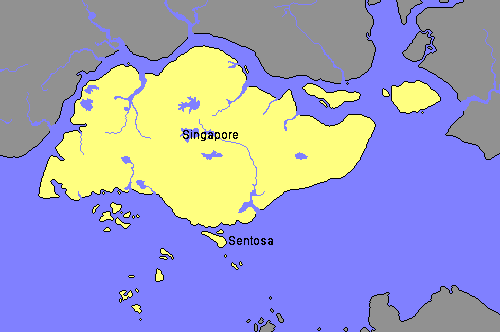
Singapore: Singapore is an island city-state located at the southern tip of Peninsular Malaysia. Following independence from the British, Singapore joined other former British colonies in the formation of Malaysia in 1963. However, due to political, economic, and social differences with the rest of Malaysia, leading to widespread racial riots, Singapore seceded from the union and became an independent city-state in 1965.
Written records as early as the second century identify modern day Singapore as an important trading post. According to local lore, Singapore was given its name when a prince was shipwrecked on the island and came across a strange-looking animal. He was told it was a lion and, taking it as a sign, decided to found a new city named Singapura, from singa, meaning lion, and pura, meaning city. Even though the animal he saw was more likely a tiger, since lions have never lived on the island, it is still know as the lion city today.
Getting There: We woke up at 4:00am to catch our early morning flight from Kuala Lumpur to Singapore. The flight itself was short, less than an hour, but we had to wait a short time after we landed until our ground transportation arrived. We made our way to the hotel, checked in, and, since we had no tours scheduled, we headed out to see the city on our own, after first checking which sites we would see with our tour the following day to avoid any repeats.
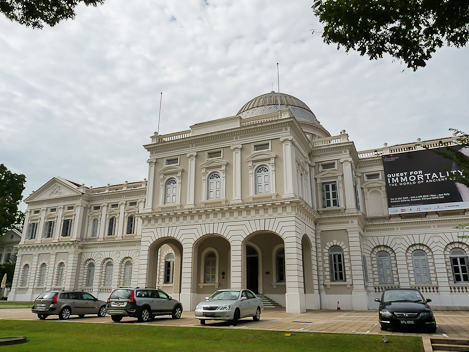
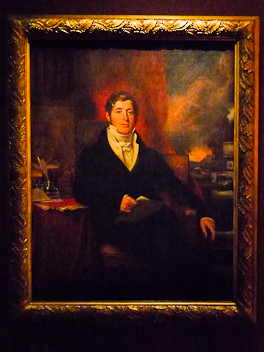
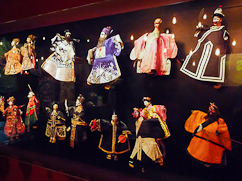
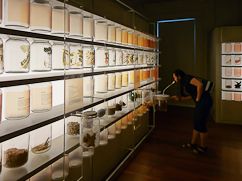
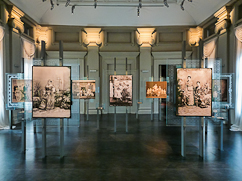
National Museum of Singapore: A short walk from our hotel sits the National Museum of Singapore, so it seemed the perfect place to start. We purchased tickets for the permanent exhibit only, starting at the Singapore History Gallery. With audio tours in hand we started learning about the prehistory of the island, leading up to the founding of the city of Singapore. We then jumped ahead to the early nineteenth century with the arrival of Sir Thomas Raffles, the founder of the British colony in Singapore. The tour was very detailed and took us through the British era, the Japanese occupation, and to modern day Singapore. We spent about two hours in this gallery alone.
We then proceeded to the second section of the permanent exhibition - Singapore Living Galleries. Here, we learned a little about Singapore Fashion, Film & Wayang, Food, Bags, and Photography.
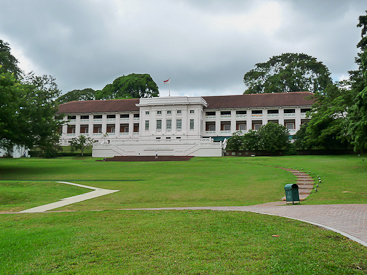
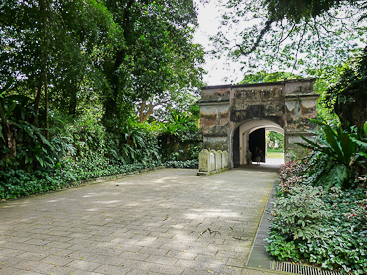
Fort Canning Park: The National Museum of Singapore sits at the foot of Fort Canning Hill, so we headed up until we came to Fort Canning Center. Built by the British as an army barracks, it now houses the National Parks Visitor Center, function rooms and theater facilities. Further up the hill lies the Fort Gate, the only remnant of the fortress that protected Singapore from 1861 to 1926.
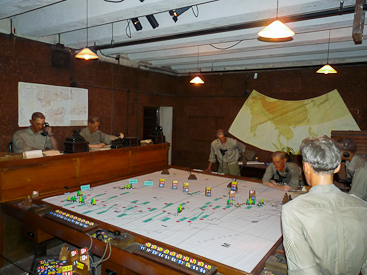
Battle Box: Our next stop in Fort Canning Park was at the Underground Far East Command Center, commonly known as the Battle Box. The Battle Box is an underground bunker built by the British in 1936 to serve as their command center for Southeast Asia in the event of a war. The 26 room complex was used for that purpose during World War II. It was here that the British surrendered Singapore to the Japanese on 15 February 1942 in one of their greatest defeats. The Battle Box is fully restored and an admission fee is required to enter. Upon entering, we caught up with a tour for one of Singapore's military schools.
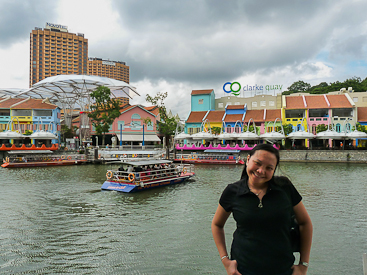
Clark Quay: Following our tour we were ready for some lunch, so we headed to Clarke Quay on the opposite side of Fort Canning Hill from the National Museum. Originally the location of warehouses for goods entering Singapore, Clark Quay, named after Singapore's second Governor, has since been converted into a commercial center with many restaurants and night clubs. Located on the Singapore River, it has several floating restaurants and is a popular stop for river taxis and river tours. After lunch, we headed down river on foot to see some of Singapore's landmarks.
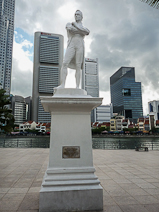
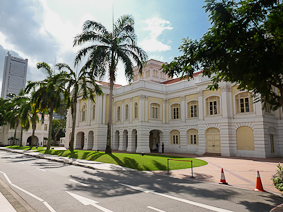
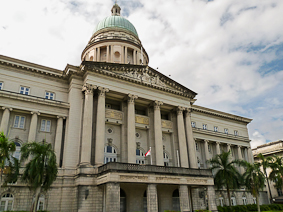
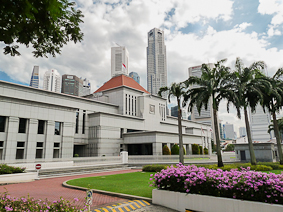
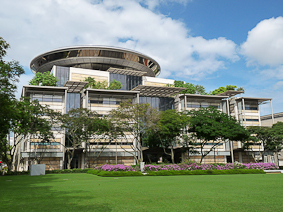

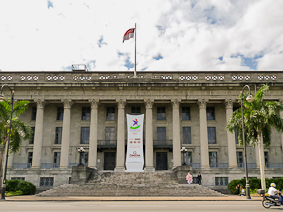
Landmarks & Government Buildings: The first landmark we came across was a statue of Sir Thomas Raffles, marking the spot on the bank of the Singapore River where he first landed. From there, we headed away from the river and arrived at the Arts House at the Old Parliament,the oldest surviving government building in Singapore. Continuing on our walking tour, we saw the Old Supreme Court, which will be refurbished and converted into an arts and culture center, the Supreme Court, and the Parliament House, where we entered the visitor's center and learned a little about Singapore's parliamentary elections and procedures. Returning to our walk, we eventually reached St. Andrew's Cathedral, the country's largest cathedral, and completed our loop at City Hall, which sits next door to the Old Supreme Court building.
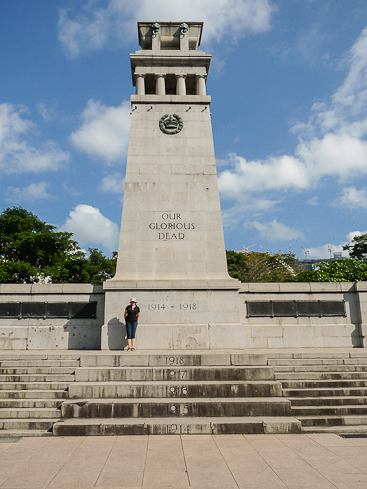
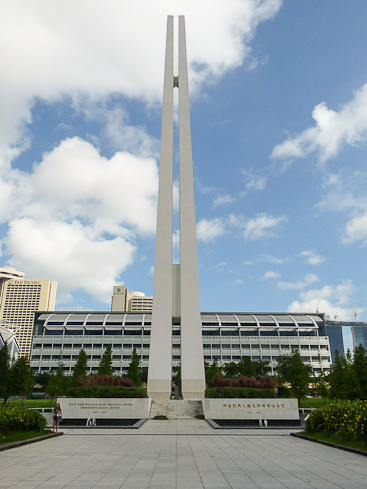
Memorials: Directly across the street from City Hall is the first of two memorials we visited, the Cenotaph. It was completed in 1922 and was built to commemorate the 124 British soldiers from Singapore who perished in World War I. A short walk up the road from the Cenotaph brought us to the War Memorial Park. Located within the park is the Civilian War Memorial, affectionately referred to as the Chopsticks, erected in 1967 in remembrance of the civilian victims of the Japanese occupation during World War II. The 61 meter (120 feet) tall columns represent the Malay, the Chinese, and the Indians, with the last one encompassing all other races. The remains of unidentified civilian victims are interred beneath the monument.
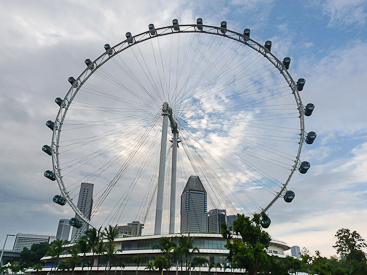
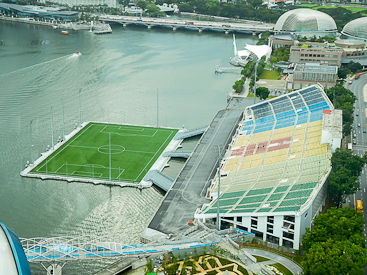

Singapore Flyer: Peep had wanted to ride the Singapore Flyer, the largest observation wheel in the world. We started off in that direction when, a short time later, it started raining. The rain quickly turned into a downpour. Fortunately, Peep and I saw it coming and were able to duck into a nearby mall until it blew over.
We finally made our way to the Singapore Flyer and, grabbing our audio tour headphones on the way, entered one of the capsules for the 30 minute trip. We saw many of the attractions in that part of the city, including the Float at Marina Bay, a giant floating stage, and the Esplanade, a performance arts venue commonly referred to as The Durian, a pungent tropical fruit, due to its design. We were also able to look down on the Marina Barrage, a recently completed dam across the Marina Channel, effectively turning Marina Bay into a freshwater reservoir to help supply the growing demands of the city. Beyond the Barrage, we could see the numerous ships anchored in the Straits of Singapore.
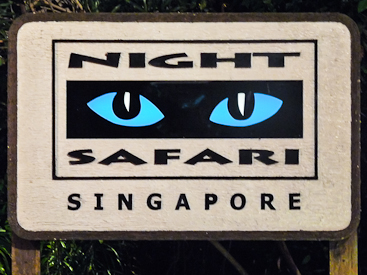
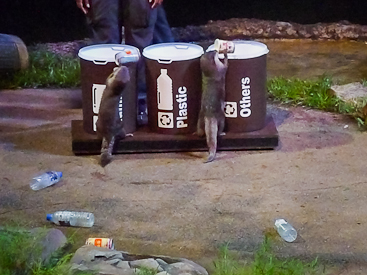
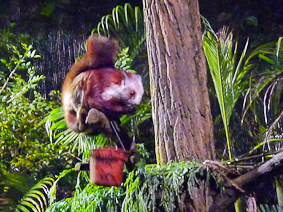
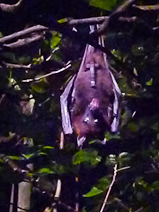
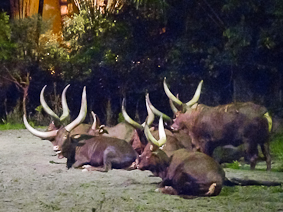
Night Safari: After our experience on the Singapore Flyer, we headed for the subway where we caught the train out of downtown. At our stop, we transferred to a bus for the final leg of our journey to the Night Safari. The Night Safari is located next to the Singapore Zoo and showcases nocturnal animals through a couple of shows, several walking paths, and a tram ride to numerous exhibits. When purchasing our tickets, we decided to get a two-park combination ticket, allowing us access to not only the Night Safari but also to the Jurong Bird Park, since we had no plans following our tour the next day.
We first caught the Creatures of the Night show, where binturongs, otters, raccoons, owls, wolves, hyenas and servals were featured. After the show, we headed to the tram station, catching the next tram for a ride halfway around the park. At that point we disembarked and walked the Leopard Trail, stopping in to see the Giant Flying Squirrels and Fruit Bats. After completing our hike, we hopped back on the tram for the second half of the ride.
Having completed our visit to the Night Safari, we grabbed a very late dinner before boarding the bus for the ride back to the train station. By the time we arrived, the last train had already departed, so we ended up taking a taxi back to the hotel before collapsing into bed shortly after midnight.

